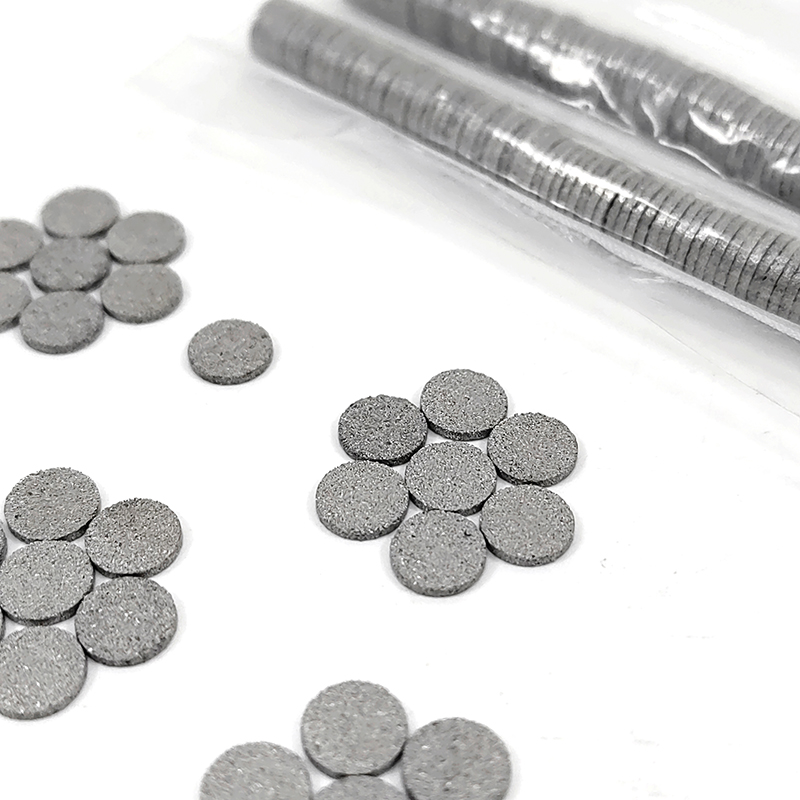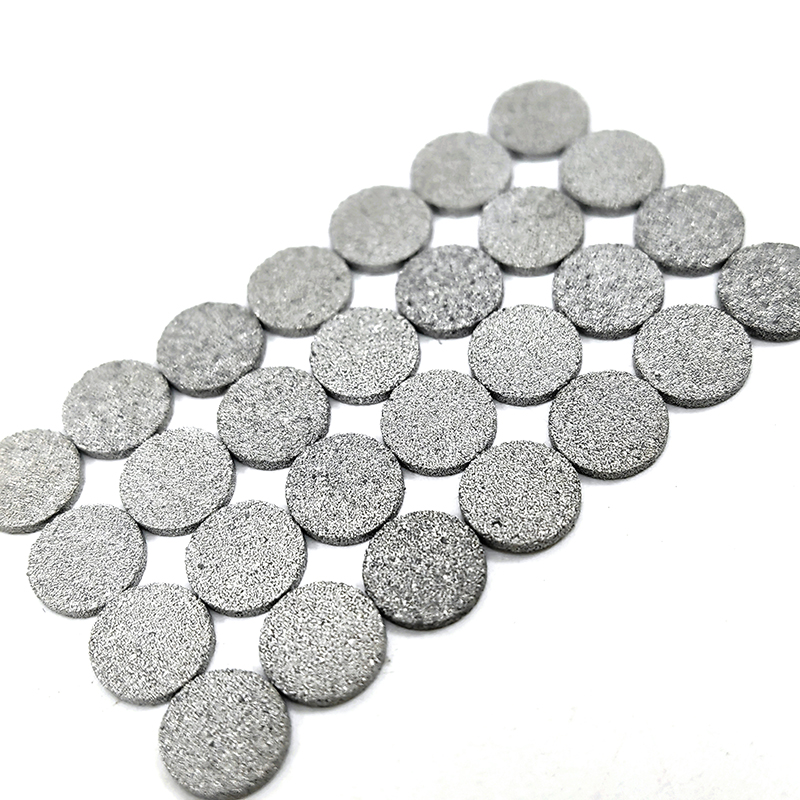What is a Sintered Metal Filter Disc? A Comprehensive Guide
- 1. Intro and Interpretation
- 2. Materials and Production Processes
- 3. Key Physical and Efficiency Properties
- 4. Purification Performance Evaluation
- 5. Applications Across Industries.
- 6. Comparison with Alternate Purification Media
- 7. Lifecycle Considerations: Design, Selection, Maintenance, and Failing Analysis.
- 8. Arising Patterns and Future Overview
1. Intro and Interpretation
A sintered steel filter disc is a crafted porous framework used for dividing strong fragments from fluids or gases. Made via powder metallurgy, fine steel powders are compressed and warmed below their melting factor (sintering). This bonds fragments, developing an inflexible, interconnected porous connect with controlled spaces for purification. Their key feature is dependable, reliable filtering in demanding settings where various other media fall short.
2. Materials and Production Processes
Product selection relies on application needs (chemical, thermal, mechanical). Common materials consist of stainless steel (e.g., 316L) for corrosion/heat resistance, nickel alloys (Hastelloy, Inconel, Monel) for aggressive chemicals/high temperatures] titanium for aerospace/medical uses (toughness, corrosion resistance, biocompatibility), and bronze for cost-effectiveness in lower-pressure systems . Specialized alloys like Alloy 20 and Tungsten Carbide are used for particular problems.
Production includes:
- Powder Prep Work: Choosing top notch steel powders with controlled residential properties.
- Compaction: Compacting powder right into form (pushing, isostatic pressing, or gravity sintering).
- Sintering: Heating the compressed body in a regulated ambience to bond bits and develop the permeable structure. Criteria affect pore size, porosity, and permeability.
- Second Therapies: Optional steps like impregnation, finish (e.g., asymmetric membrane layer for efficiency), or machining (laser cutting for custom forms).
Sintered modern technology produces a long-term, consistent pore framework with high mechanical strength, longevity, thermal/chemical security, and regular circulation control. Pore size is established by powder dimension and compaction.

3. Key Physical and Efficiency Properties
Filter performance depends on controlled physical residential properties:
- Pore Size Circulation: Specifies filtration precision (0.1 to 100 µm regular range).Dictates minimum kept fragment dimension.
- Leaks in the structure: Relieve of fluid circulation with the structure, affecting stress decrease. Influenced by pore size, porosity, tortuosity.
- Mechanical Toughness: Withstands high stress (> 3000 PSI/100 bar) and stress. Improved by external rings.
- Corrosion Resistance: Material-dependent; stainless steel provides great resistance, nickel alloys for aggressive media.
- Thermal Security: Runs from -200 ° C to 1000 ° C depending upon alloy. Stands up to thermal shock.
- Porosity: Percent of void quantity (generally 28-50%). Affects leaks in the structure and strength.
- Surface Area: Huge internal location help dust holding ability and catalytic usages.
- Cleanability: Can be cleaned up and reused, recouping > 95% performance, prolonging lifespan and lowering expenses.
Residence are measured using standard tests (bubble point, permeability, toughness, cleanliness, etc).
4. Purification Performance Evaluation
Performance metrics consist of effectiveness, stress decrease, dirt holding capability, and life span.
- Filtration Performance: Capacity to eliminate particles (often > 99.9% for 0.1-100 µm). Can work as deepness or surface filters.
- Dust Holding Ability: Quantity of contaminant maintained before too much pressure decline. Connected to pore framework and surface area.
- Service Life: Influenced by running problems, pollutants, and maintenance. Can last 3-10+ years with proper care.
Complicated circulations (multi-phase, non-Newtonian) and short-term impacts need customized models.
5. Applications Across Industries.
Sintered steel filters are utilized in diverse sectors because of their robustness:.
- Chemical/Petrochemical: Warm gas purification, driver healing, hostile liquid filtering.Stainless-steel and Hastelloy prevail. Used in refining.
- Drug: Critical filtering, vapor sterilization, high pureness requirements. Titanium is usefulSlope systems are made use of.
- Food & Beverage: Liquid/gas filtering, steam sanitation.
- Aerospace: Hydraulic/fuel filtering, high temperature/pressure applications. Titanium is vital.
- Automotive: Liquid and gas purification in high-pressure systems.
- Semiconductor: High-purity filtration.
- Power Generation: Warm gas filtration (e.g., IGCC plants).
- Water Therapy: Stainless steel for rust resistance.Utilized in microfiltration.
- Other: Gas diffusion (sparging), sound dampening, heat/fluid monitoring, catalyst sustains.
Personalization of geometry, pore dimension, and product allows customizing for certain demands.
6. Comparison with Alternate Purification Media
| Function | Sintered Metal Filters | Ceramic Filters | Woven Meshes | Polymer Membranes | Fibrous Media | Metal Fiber Filters |
|---|---|---|---|---|---|---|
| Mechanical Toughness | High | Moderate; breakable | Moderate | Reduced | Reduced | High 20 |
| Temperature level Limitation | Really High (as much as 1000 ° C) 57 | High( as much as 1500 ° C) | Moderate | Low( < 200 ° C) | Modest | Very High |
|
Corrosion Resistance |
High( alloy reliant) | Very High | Moderate | Varies | Varies | High( alloy dependent) |
|
Pore Size Control |
Accurate 5 8 57 | Attire, flexible | Specified by weave | Very great feasible | Large range, less uniform | Engineered 20 |

7. Lifecycle Considerations: Design, Selection, Maintenance, and Failing Analysis.
Reliable usage needs careful layout, choice, upkeep, and failure analysis.
7.1 Style and Choice.
Selecting a filter entails evaluating:.
- Fluid/Gas properties (structure, temp, pressure).
- Impurity qualities (type, dimension, concentration).
- Circulation price and stress drop needs.
- Operating setting (temp, pressure, corrosivity).
- Required purification efficiency.
- Mechanical restrictions.
- Lifecycle prices.
Guidelines consist of specifying material, measurements (1-10mm thickness, up to 3000mm size), pore dimension, precision, and flow price. Custom-made forms are possible.Pilot testing and requirements (ISO 9001, ASME) are very important.
7.2 Maintenance and Cleaning.
Routine upkeep stops obstructing and prolongs life-span. Cleansing restores efficiency.
Reliable cleaning techniques:.
- Backflushing: Opposite flow to remove bits.
- Ultrasonic Cleansing: Utilizing waves in option.
- Chemical Cleaning: Soaking in solvent/solution.
- Thermal Cleaning (Calcination): Heating to burn organics.
- Blow-off: Utilizing pressed air [30]
- Saturating: Submerging in solvent for hefty contamination.
Physical approaches are usually more eco-friendly. Performance is monitored by leaks in the structure healing [29] Particular methods relate to stainless-steel and bronze filters.
7.3 Failure Evaluation.
Comprehending failure settings aids fixing and avoidance. Usual settings:.
- Corrosion: Chemical strike derogatory material.
- Surface Interaction: Reactions with media.
- Occlusion: Particle accumulation obstructing pores.
- Mechanical Failure: Fracturing, deformation from pressure, stress, exhaustion.
- Tension Deterioration Cracking/Hydrogen Embrittlement: Failure in destructive, stressed problems.
- Media Movement: Filter product launching into filtrate.
- Welding Issues: Problems near welds.
- Erosion: Wear from abrasive bits.
- Production Problems: Non-uniform porosity.
- Thermal Shock: Stress from rapid temperature modifications.
- Hydrolysis: Failing due to moisture/conditions.
Diagnostic techniques:.
- Visual Assessment: Looking for damage/debris
- Microscopy: Checking out surface, bits, chemical effects
- Pressure Drop Surveillance: Shows clog
- Elemental Analysis: Identifying contaminants
- Permeability Screening: Analyzing blockage/degradation
- Mechanical Testing: Examining toughness
- Honesty Testing: Checking architectural sturdiness
- Particle Retention Screening: Confirming capture capacity
- Thermal Imaging: Detecting locations
- Other tests: Cleanliness, chemical analysis, performance, metallography
Avoidance includes material choice, optimizing specifications, pre-filtration, regular cleaning, proper handling, and surface treatments. Predictive maintenance makes use of real-time monitoring and fad evaluation.] Addressing manufacturing issues is essential
8. Arising Patterns and Future Overview
The area progresses with material and production developments.
Additive Production (AM) (3D printing) is a fad, making it possible for complex geometries and optimized circulation paths not feasible conventionally 45. AM allows accurate control and personalization for filtration, fluid control, and lightweight usages 46. Products consist of stainless steel and titanium. Processes like powder bed combination and Binder Jetting are made use of by companies like Mott, Croft, GKN, and Poral 45 48. AM provides practical combination, material/energy savings, and inherent durability/backwash capacity 47.
Functionalization to pass on catalytic properties is one more location 50 51 54. Compounds like carbon nanofibers on metal fiber filters serve as catalyst sustains 50. These can form Structured Supported Ionic Fluid Phase (SSILP) stimulants 50. Research explores novel permeable drivers utilizing bimetallic MOFs and lignin 51. Sintered filters' residential properties suit assimilation into catalytic processes.
The market is anticipated to expand because of advantages in demanding applications. Challenges consist of competition from nanofiber and ceramic filters. Makers concentrate on cost efficiency, product flexibility, and enlightening customers on long-lasting advantages 26. Hybrid ceramic-metal composites are also arising for ultra-fine capture 21.
The future entails advancement in AM and brand-new functionalities like catalytic task to expand applications and boost efficiency.

What is Sintered Metal Filter? Complete Guide by Lvyuan

Sintered PTFE Filters: Advanced Filtration for Demanding Environments

Metal Sintered Filters: Precision Filtering to Drive Industrial Upgrading

Choosing Sintered Filters: An Overview for Industrial Applications

What Are Sintered Metal Filters and How Do They Work?

5 Benefits of Using Titanium Filters for Filtration
Sintered Titanium Filters
What is the Lifespan of Sintered Titanium Filters?
With proper care and maintenance, sintered titanium filters can last up to 30 years, providing a durable and cost-effective solution for filtration needs.
Sintered Metal Filter
What is the cleaning process for industrial sintered metal filter cartridges?
Cleaning methods include backwashing, ultrasonic cleaning, chemical cleaning, or a combination of these, depending on the type of contaminants and the cartridge material.
Sintered mesh filters
Can sintered mesh filters be customized for specific requirements?
Yes, sintered mesh filters are highly customizable. They can be tailored based on factors such as filtration rating, material composition (e.g., stainless steel, monel), dimensions, and shape to meet the unique needs of different applications.
How can I select the right sintered mesh filter for my application?
To select the right sintered mesh filter, consider factors such as filtration requirements, material compatibility, temperature and pressure conditions, and specific application needs. Consult with the manufacturer for guidance on customization options.
For products
Do you provide customization for sintered metal filters?
Yes, we offer customization services to tailor sintered metal filters to your unique specifications. This includes variations in size, shape, material, and micron rating to ensure the filter meets the specific demands of your application.

Sintered powder metal filters
Sintered powder metal filters are crafted from compressed and sintered metal powders, forming a porous structure. Porosity: 28%-50% Permeability: 0.02-20L/cm²minPa Pressure Resistance: 0.5Mpa Temperature Resistance: Less than 280℃

Bag filter housing
Bag filter housings are essential components in industrial filtration systems, designed to remove contaminants from liquids. To enhance the functionality and efficiency of bag filter housings, various features can be incorporated.

Sintered wire mesh filter
Benefit from outstanding high-pressure resistance and consistent filtration efficiency with Lvyuan's sintered metal mesh. Our sintered wire mesh finds versatile applications in diffuser screens, centrifuges, breather vents, fluidized beds, chromatography, polymer processing, petrochemical industries, hydraulic filters, and more.

Stainless steel multi cartridge filter housing
Discover unparalleled filtration efficiency with our Stainless Steel Multi Cartridge Filter Housing – a testament to precision engineering and reliability.

Sanitary filter housing
This filter housing will allow you to filter large volumes of nanoemulsion with ease. Sanitary vent and drain valves permit easy venting, draining, sampling, or integrity testing operations. The new cartridge locking design features additional cut-outs for traditional half-moon portions of the Code 7 bayonet locks, enhancing clean ability and drain ability.

stainless steel filter water
Lvyuan’s sintered stainless steel filter stands as a pivotal filtration element crafted through a meticulous sintering process, with stainless steel serving as the core material.

Stainless steel pleated filter cartridge
Lvyuan Stainless Steel Pleat Filter Cartridge constructed from high-quality SS 304 or SS 316L material, this filter exhibits exceptional resistance to high temperatures and rust.

Stainless Steel Duplex filter housing
As the manufacturer, we offer a comprehensive range of Duplex Filter Housings designed to provide efficient and reliable filtration solutions for various industrial applications.
© 2024 Lvyuan All Rights Reserved. | Privacy policy • Terms and conditions
